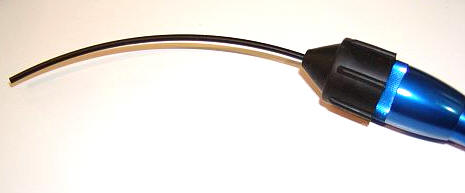Checking the bore and rifling of a gun
Posted: Tue Jul 19, 2022 12:27 am
Brothers:
This post is only a description of how I check bores of handguns and rifles -- it isn't meant to be a "this is how it's done" rule. For those of you who already have a good way of checking bores, it probably won't be helpful. For others, it might be -- I hope so.
I use a Maglite double AA size flash light ("torch") and a cheap accessory that's sized for them that has a coated fiber optic element. This picture describes it better than I can:

You see how the large end slips over the reflector of the flash light, and the beam is aligned with the fiber optic part. This will give a nice, bright spot of light wherever you point the end of the fiber optic. This beam can be optimized by holding the fiber optic from a surface that is about as far away as the distance you want to use the flash light, and then adjusting the reflector focus.
These AA-size Maglites are very common and can be bought in many places. It could be that the attachment will fit other brands and types of flash lights -- I don't know about that.
The attachment is available from a number of online vendors, like Amazon and eBay, if you can't find them in a local store.
Of course, there are many other ways to check a bore. Some use mirrors of various shapes, and there are purpose built bore scopes which might do a better job. If I'm going to a gun show, I have a little single AAA size flash light that fits in my pocket that I'll bring with me. It can fit in a receiver of a bolt action gun, if needed.
I like the Maglite attachment though, because I have a couple of double AA Maglites and use them for all sorts of things, like working on cars, electric trains, and other things beside guns. They are great for holding in the mouth when both hands are needed for a job, too.
A strong source of light is very helpful for determining the condition of the bore, as well as the presence of lead deposits and other rubbish that can collect in them. I've even used my fingernail as a reflector in a pinch, although it doesn't give very good light at all for checking a bore. I recommend carrying some kind of bore light whenever you go to look at guns for purchase. Doing so also works well for examining the individual chambers of revolvers.
This post is only a description of how I check bores of handguns and rifles -- it isn't meant to be a "this is how it's done" rule. For those of you who already have a good way of checking bores, it probably won't be helpful. For others, it might be -- I hope so.
I use a Maglite double AA size flash light ("torch") and a cheap accessory that's sized for them that has a coated fiber optic element. This picture describes it better than I can:

You see how the large end slips over the reflector of the flash light, and the beam is aligned with the fiber optic part. This will give a nice, bright spot of light wherever you point the end of the fiber optic. This beam can be optimized by holding the fiber optic from a surface that is about as far away as the distance you want to use the flash light, and then adjusting the reflector focus.
These AA-size Maglites are very common and can be bought in many places. It could be that the attachment will fit other brands and types of flash lights -- I don't know about that.
The attachment is available from a number of online vendors, like Amazon and eBay, if you can't find them in a local store.
Of course, there are many other ways to check a bore. Some use mirrors of various shapes, and there are purpose built bore scopes which might do a better job. If I'm going to a gun show, I have a little single AAA size flash light that fits in my pocket that I'll bring with me. It can fit in a receiver of a bolt action gun, if needed.
I like the Maglite attachment though, because I have a couple of double AA Maglites and use them for all sorts of things, like working on cars, electric trains, and other things beside guns. They are great for holding in the mouth when both hands are needed for a job, too.
A strong source of light is very helpful for determining the condition of the bore, as well as the presence of lead deposits and other rubbish that can collect in them. I've even used my fingernail as a reflector in a pinch, although it doesn't give very good light at all for checking a bore. I recommend carrying some kind of bore light whenever you go to look at guns for purchase. Doing so also works well for examining the individual chambers of revolvers.